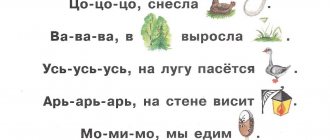APPLE
The amber apples are ripe on the apple tree. Yana and Yasha ate amber apples. (N. Lunina) Everyone knows what an apple looks like. This is not surprising. An apple is among fruits as a potato is among vegetables. Apple orchards on our planet occupy five million hectares. This is the most common fruit tree. The apple has been known to people since ancient times. There is a mention of this fruit in the Bible. It was the apple that Eve plucked from the tree of the knowledge of good and evil. Ancient Greece is considered the birthplace of the home apple tree. The ancient Greeks and Romans considered the apple a symbol of love and dedicated it to the goddess of beauty. The ancient Germans were sure that apples were the favorite fruit of the gods. They planted apple trees around their houses, hoping that the evil storm god would not throw lightning arrows at them. In Russia, apple trees began to be grown already in the 11th century. In 1051, an apple orchard was founded in the Kiev Pechersk Lavra. The first apple orchards appeared in the Moscow region in the 12th century. by order of Yuri Dolgoruky.
On August 19, Rus' celebrated the Apple Savior. Until this time, apples were not supposed to be picked. On this day, ripe fruits were collected from apple trees and blessed in churches. Apples were given to the poor and homeless. The more beggars you treat, the more abundant the harvest will be next year. Housewives baked apple pie on this day. Several hundred varieties of apples are known in Russia. They are divided into summer, autumn and winter. In the second half of September, winter varieties of apples were collected: Antonovka and Semerinka. The skin of these varieties is thick, with a special waxy coating that protects the fruit from rotting. You can store them until spring. Apples are eaten fresh, dried, soaked and frozen. They are used to prepare juices, compote, jam, jam, marmalade, and jelly. Apples are very useful. It is no coincidence that the Russian people created a fairy tale about rejuvenating apples. Eat them and you will be young and healthy. Apples contain vitamins, sugars, iron, potassium and magnesium salts. RIDDLE Same with a fist, Red barrel. If you touch it with your finger, it’s smooth, And if you bite it, it’s sweet. (Apple) PROVERBS AND SAYINGS • September smells like apple, October smells like cabbage. • No apple falls past the apple tree. • Like the tree, so are the apples.
Poems about food for children
N. Kapustyuk. “You can’t live without garlic”
A poem about the need for garlic. It is not consumed in its pure form, but as an additive it adds a pleasant taste and aroma to various dishes. The author also has many poems about individual vegetables and fruits.
A. Prokofiev. "Garden"
A short poem about the variety of vegetables grown in the garden. The verse is easy to memorize to remember the names of vegetables.
E. Ranneva. "Tomato - traffic light"
The tomato in the poem is compared to a traffic light. It turns from green to red. Children learn how tomatoes grow and ripen, that they do not appear as red as in the store, and that ripening tomatoes is a slow process.
N. Shemyakina. "Hand Rain"
The poem describes watering vegetables from a watering can. Children should know how to care for plantings so that they grow into tasty vegetables.
L. Generalova. "Useful onion"
A poem about the benefits of onions. Despite the fact that it makes people cry, it is not evil, but very kind - it protects against diseases and germs. Children will learn from the poem why onions are useful.
T. Lavrova. "What is bread made from..."
In a short poem, the author talks about the production of bread, about what a long and painstaking process it is. Also describes the variety of baked goods. All of them are baked from flour obtained from wheat.
PEAR
Pear is very tasty. We are very sad without a pear. Pear is delicious, especially in jam. (I. Goryunova) In terms of popularity and space occupied, the pear is in third place after the apple and cherry trees. Pear cultivation began a long time ago. The ancient Roman writer Cato the Elder, in his treatise “On Agriculture,” written more than two thousand years ago, gave recommendations on how to properly grow pears. Pliny the Elder described 35 varieties of pears in his work. Unlike modern varieties, pears in ancient Rome were hard. They became soft at the end of the 18th century thanks to the efforts of French and Belgian breeders. One of them, Van Monet, developed 400 varieties of pears, 40 of which are still popular today.
Now the number of pear varieties has exceeded several thousand. Pears are grown in gardens; they also grow on forest edges and in clearings in deciduous forests. It feels good on rocky mountain slopes, as it is not picky about the soil and tolerates drought and light frosts. Pear trees begin to bear fruit in 5–7 years. True, at first the harvest is small. But when the tree gains strength, they get up to 200 centners per hectare. Pears live quite a long time, up to 300 years. The oldest fruit tree in the world is considered to be a pear tree, planted in 1630 within the American city of Denver. A wonderful pear, very sweet, like honey. It just begs to be placed in your palm, and then quickly into your mouth. (N. Migunova) The pear fruit consists of 97% pulp, 2.5% is the skin and only 0.5% is the seeds. It contains vitamins D and C, potassium, magnesium, and iron salts. Pears are eaten fresh, many delicious dishes are prepared from them, jams, jams, compotes are made, pears are dried and pickled. RIDDLE Birds hang upside down on the trees between the leaves. (Pears)
Tasks
Examples of tasks that can be used during lessons on the topic “Fruits”:
- Describe the appearance of several fruits using object pictures with their images.
- Compare two similar fruits (apple-peach, pear-quince, tangerine-orange), listing in detail all the common features and differences.
- Name as many characteristics of the fruit shown on the card as possible. One child, children in pairs, or the whole group can list adjectives in a circle.
- Make up a story based on the plot picture, and also come up with several questions for each picture. You can use the following options: “Fruit basket”, “How dried fruits are made”, “From seed to apple”.
- Choose an image of one fruit and come up with as many dishes from it as possible, using the correct name for each (plum marmalade - plum caramel - plum jam).
- Write riddles or short funny poems about fruits on cards.
- Carefully examine one of the pictures, and then, from memory, describe in great detail the fruit that is depicted in it.
- Make up stories in pictures based on several drawings on a topic that are related to each other.
- Using various dried and fresh fruits drawn, come up with a fairy tale about them, compose a short dialogue, and act out (using cards) a short scene.
Fruit basket
Peach
Mandarin
Lemon
Kiwi
Pear
Pomegranate
Banana
Quince
Plum
Cherry
Persimmon
QUINCE
Transcaucasia and Central Asia are considered the homeland of quince; it is in these areas that it is now found in the wild. Quinces have been grown since time immemorial, more than 4,000 years ago. The Latin name for quince is Cytfonia, presumably derived from the city of Cydon on the island of Crete; it was widely cultivated already in the first millennium BC. The ancient Greeks treated the quince with respect; for them it was a symbol of beauty and fertility. It was customary to treat newlyweds to quince. According to one version, the cause of the discord between Hera, Athena and Aphrodite was not an apple, but a quince. Currently, about 400 varieties of quince are known. They differ from each other in the structure of flowers and the shape of fruits. True, the differences between them are not as significant as, for example, between apple varieties.
Quince fruits are yellow in color with different shades, sometimes with a slight blush, very dense, hard and crunchy. If there are greenish spots on the quince, it means that it is not yet fully ripe. The pulp of this fruit is slightly viscous, tart and quite aromatic - the smell has something of an apple, and there is also a coniferous tint. You should only eat ripe quince; it is advisable to give it a chance to age. The longer it sits, the tastier, more aromatic and softer it becomes, the astringent taste disappears. Quince is a very healthy fruit. It contains potassium, magnesium, calcium, vitamin C, malic and citric acids. Quince pulp is rich in pectin. Quince is a universal fruit. It is eaten raw, it makes delicious compotes, jams, preserves, candied fruits, it can be added to porridge, salad, vegetable soup. Quince mustard is a seasoning made from quince and mustard with the addition of ginger and coriander. Quince cheese is condensed quince juice with pulp. Quince is grown in many countries of the world - in Europe, North America, North Africa, East and Central Asia. Cold-resistant varieties have also been developed and are successfully cultivated in the Volga region. Another variety of quince is Japanese quince, or chaenomeles. The flowers and fruits of this plant are similar to quince. Chaenomeles was brought to Europe from Japan at the end of the 17th century. Gradually it gained popularity among gardeners - it has very beautiful decorative flowers. Japanese quince fruits are also edible, but they are more sour.
Pages: 1 2 3 4
Tale "about Fruits"
The author of the fairy tale is Olga Nikolaevna Syrovatina. Duration 4 minutes. Publication date 10/25/2017
Alternative audio player
Three extraordinary moon horses, harnessed to a beautiful air carriage, rushed like a whirlwind across the vast expanses. Her Majesty Queen Leto was returning to her dominions.
- Oh, you, my horses, majestic horses!
These were three brothers - the youngest was called June, the middle was July, but the queen's eldest favorite was called August. The queen's followers eagerly awaited her arrival. There was bustle in the domain.
- Jump ahead, June, and warn everyone that I’m returning! - the queen ordered him. The horse shook his sunny mane, took off and ran so fast that warmth spread from under his hooves throughout the entire area.
Fruits and berries gained this warmth and began to ripen. The Cherry Countesses changed their green dresses to bright red ones. Mrs. Strawberry put on a beautiful scarlet sundress.
And Queen Leto, having traveled half of her journey, decided to send her next horse ahead. July shook his mane and galloped faster than his younger brother, rushing like a whirlwind, so much so that from under his hooves the heat spread throughout the entire area. The first to notice July were Apple's ladies-in-waiting, which means it's time to change your outfit, and let's apply a pink blush to your round cheeks.
Looking at them, Baron Peach, who was still in his green doublet, admired their new multi-colored outfit and the aroma that wafted from these handsome men.
The queen was in a hurry. Spurring her horse Augustus, she raced towards her palace.
– It's time to put on your favorite purple outfit! - said the court lady Plum, looking at herself in the mirror - I look amazing in it and so graceful! – this favorite of the Queen admired herself out loud.
Suddenly there was a knock on the door. Plum opened it. Mr. Viscount Apricot stood on the threshold. He had already preened himself by putting on a bright orange camisole; this color suited his cheerful appearance very well.
In the queen's domain, preparations were underway for the great Harvest Festival. Gentlemen brought fruits and berries from all gardens and vegetable gardens here.
“Look,” Cherry Little said quietly to Peach, pointing her gaze at the round nobleman, whose camisole had light and dark green stripes, “Who is this?”
But he, noticing the lady’s curious look, approached them and introduced himself:
“I am Prince Watermelon, I came from the southernmost region,” he said.
-So you’re not a fruit? - Chereshenka asked him.
- No, of course, I’m a berry! - Watermelon said proudly.
- This can’t be! Are there really such berries, huge, and even with a thick peel?
- Yes, I am! - and he, pleased with himself, walked away from them.
– This time the holiday will be very noisy and fun, because so many guests have arrived - the list of invitees is simply huge! – Plum rejoiced.
She was the main one at this holiday and was very proud of it. Her dark purple outfit flashed among the guests in the halls.
– Gentlemen, there is very little time left before the arrival of Queen Summer, the Harvest Festival is about to begin! Please take your seats, and I will read out the list of invited guests to all of you.
- Welcome! Apples, Pears, Cherries, Cherries are here and Mrs. Quince, Apricots, Peaches, Plums. Oh! this list is very long, I need to take a little break,” said Sliva. And suddenly Countess Cherry saw the belated guests:
– Look, what kind of unusual fruits came to us? Personally, I'm not familiar with them. – Plum hurried to meet them.
- Hello, gentlemen Fruit! Welcome to our Harvest Festival! The guests began to introduce themselves:
- I am Baron Orange, and these are my relatives - Senors Lemon and Mandarin - they were all in beautiful orange clothes.
“Allow us to introduce ourselves,” an amazingly beautiful fruit with green hair on its head came forward and said with a bow:
– My name is Pineapple, and these are my friends: Bananas and Figs.
- And I’m Khurma, and he’s Kiwi, and we all came from afar, from overseas countries.
– We are very, very glad to see you! – Plum smiled at them.
- We're finally home! - said the queen.
She waved her right hand high and immediately her three horses turned into three young men. At the same instant, the queen waved her left hand high, and all the elegant ladies and gentlemen instantly turned into juicy ripe berries and fruits. Well done, they carefully collected all these fruits and berries into beautiful baskets.
Summer admired the harvest.
– What great benefit to people from my three months of June, July and August! - Summer said majestically.
Listen on YouTube
If you liked the fairy tale, subscribe to the author’s channel to be notified of the publication of new fairy tales
Source





